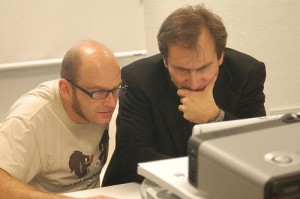Podcast: Play in new window | Download
Subscribe: Apple Podcasts | RSS
We talk with electrical engineer Bob Schmidt about troubleshooting in this episode of The Engineering Commons podcast.
- Please help us improve the podcast by filling out our 2014 Listener Survey!
- Adam, Brian and Jeff agree that troubleshooting computer software problems can be a frustrating process.
- Our guest for this episode is Bob Schmidt, an electrical engineer with 40+ years of experience dealing with software, hardware, and system design.
- Bob obtained an FCC first-class radiotelephone operator license at the age of eighteen.
- A Motorola 6800 microprocessor provided the computational power for Bob’s first computer, which had 512 bytes of memory.
- Bob got interested in troubleshooting when he realized he was being specifically paid to deal with problems.
- We often learn useful lessons through “parables of problem solving.”
- “The Dog Barks When the Phone Rings: An Engineer’s Guide to Solving Problems” is Bob’s new book about troubleshooting. Look for the second edition of the book, which will be published any day now!
- Another troubleshooting reference is David Agans’ book, “Debugging: The 9 Indispensable Rules for Finding Even the Most Elusive Software and Hardware Problems.”
- Bob Pease’s book, “Troubleshooting Analog Circuits,” is a problem-solving guide related specifically to electronics.
- The “five questions” approach that Bob advocates for problem-solving involves asking:
- What do you know?
- What are the rules?
- What don’t you know?
- How can you find out the stuff you don’t know?
- How do you know when you are ready to solve; or have you already solved the problem?
- It’s important to write down what you know when beginning to troubleshoot a problem.
- Our guest feels that clear communication is an important element of the problem-solving process.
- Carmen references one of Bob’s blog posts, “What Customers Don’t Understand.”
- We must be attentive to the constraints of people, time, money and results when addressing the customer’s problems.
- Henry Petroski’s book, “To Engineer Is Human: The Role of Failure in Successful Design,” discusses what can go wrong in engineering projects.
- In a 2010 presentation for the National Book Festival, Dr. Petroski talked about how the sciences and engineering are treated when successes and failures occur.
- Our guest feels that studying the designs of other engineers is a great way to get an intuitive feel for potential problems.
- Carmen references a Jim Williams tale about design titled “The Zoo Circuit: History, Mistakes, and Some Monkeys Design a Circuit.” This case study is told as a chapter in the book “Analog Circuit Design: Art, Science and Personalities.”
- Not all information on the internet is reliable, as Bob discussed in his recent blog post, “The C.R.A.P. Test.”
- It makes sense to ask experts for help in problem-solving, but one has to be cognizant of other demands on the expert’s time and attention.
- An engineer’s physical senses can be quite useful in troubleshooting problems.
- “Debug by division,” or “divide and conquer,” is a useful methodology for solving problems.
- Adam discusses how the debug process is applied in road building.
- Watching others apply the “debug by division” process is useful means for learning the methodology.
- Bob’s book offers a few “warnings” that should be heeded if you think you’ve successfully solved a problem:
- Correlation is not causation.
- Your theory of causation had better show good correlation in your experiments.
- There might be more than one correct answer.
- Undo your fix and check to see if the problem returns.
- There can be multiple paths to good solutions. Your way is not the only way.
- Never allow a defect or problem report to go by without documenting and fixing that problem.
- Additional “challenge” questions that one might ask about a possible solution include:
- How did other people solve problems similar to this problem in the past?
- Good writers of design are good readers of other people’s designs. Are you a good reader?
- Could it ever have worked that way?
- Does it work that way now?
- Are you suffering from optimism bias?
- How complete are your checklists?
- Are you doing big debug or little debug?
- Our guest feels that engineering schools should emphasize troubleshooting as an integral element of the design process.
- Bob can be found on the web at PrettyGoodProblemSolver.com.
Thanks to César Astudillo for the photograph titled “Troubleshooting.” Podcast theme music provided by Paul Stevenson.
